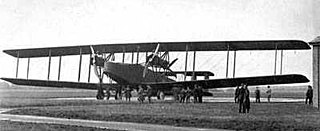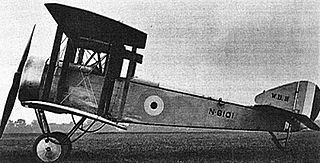Related Research Articles

The Hawker Harrier was a British experimental biplane torpedo bomber aircraft built by Hawker Aircraft to a specification issued in the 1920s for the Royal Air Force.

The Handley Page V/1500 was a British night-flying heavy bomber built by Handley Page towards the end of the First World War. It was a large four-engined biplane, which resembled a larger version of Handley Page's earlier O/100 and O/400 bombers, intended to bomb Berlin from East Anglian airfields. The end of the war stopped the V/1500 being used against Germany, but a single aircraft was used to carry out the first flight from England to India, and later carried out a bombing raid on Kabul during the Third Anglo-Afghan War. It was colloquially known within the fledgling Royal Air Force as the "Super Handley". The V/1500 which was shipped to Canada to attempt a transatlantic flight was flown in the US, and in 1919 crash-landed in a field at Mount Jewett, Pennsylvania. Photos appeared in the 20 February 1969 issue of the Bradford Journal newspaper.

The Avro 549 Aldershot was a British single-engined heavy bomber aircraft built by Avro.

The Martinsyde G.100 "Elephant" and the G.102 were British fighter bomber aircraft of the First World War built by Martinsyde. The type gained the name "Elephant" from its relatively large size and lack of manoeuvrability. The G.102 differed from the G.100 only in having a more powerful engine.

The Airco DH.11 Oxford was a British twin-engined biplane bomber which was designed to replace the earlier Airco DH.10 Amiens. It was designed to use the unsuccessful ABC Dragonfly engine and was abandoned after the first prototype was built.
The Avro 519 was a British bomber aircraft of the First World War, a development of the Avro 510 seaplane. They were two-bay biplanes of conventional configuration with greatly uneven span. Two single-seat examples, powered by a single 150 hp (110 kW) Sunbeam water-cooled engine, were ordered by the RNAS in early 1916. This was soon followed by orders for two modified aircraft for the Royal Flying Corps. These were fitted with seats for a crew of two and had more powerful (225 hp/168 kW) Sunbeam engines

The Avro 523 Pike was a British multi-role combat aircraft of the First World War that did not progress past the prototype stage. It was intended to provide the Royal Naval Air Service with an anti-Zeppelin fighter that was also capable of long-range reconnaissance and bombing.

The Nieuport 12 was a French sesquiplane reconnaissance, fighter aircraft and trainer used by France, Russia, Great Britain and the United States during World War I. Later production examples were built as trainers and served widely until the late 1920s.

The Beardmore WB.III was a British carrier-based fighter biplane of World War I. It was a development of the Sopwith Pup that Beardmore was then building under licence, but was specially adapted for shipboard use.
The Wight Seaplane was a British twin-float seaplane produced by J Samuel White & Company Limited. It was also known as the Admiralty Type 840.

The Airco DH.3 was a British bomber aircraft of the First World War. The DH.3 was designed in 1916 as a long-range day bomber by Geoffrey de Havilland, chief designer at the Aircraft Manufacturing Company. It was a large biplane with wide-span three-bay wings, slender fuselage, and a curved rudder. It was powered by two 120 hp (89 kW) Beardmore engines, mounted as pushers between the wings. In addition to tailskid landing gear, two wheels were placed under the nose to prevent it from tipping over on the nose.

The Vickers F.B.14 was a British two-seat fighter/reconnaissance biplane designed and built by Vickers Limited. About 100 were built for the Royal Flying Corps but saw only limited use as it was designed for a larger engine which was not available when production commenced and it did not meet performance expectations.
The Beardmore W.B.IV was a British single-engine biplane ship-based fighter of World War I developed by Beardmore. Only one was built.

The Beardmore W.B.V was a prototype British single-engine shipborne biplane fighter of World War I developed by Beardmore. It was not successful, only two being completed.
The Beardmore W.B.II was a British biplane fighter prototype of the 1910s.
The Sopwith B.1 was an experimental British bomber aircraft of the First World War. A single-seat, single-engined biplane, the B.1 was built by the Sopwith Aviation Company for the Royal Navy. Although only two were built, one was used for bombing raids over France.
The Grahame-White Ganymede was a prototype British heavy night bomber intended to serve with the Royal Air Force in the First World War. A large, three-engined, twin-boom biplane, the sole prototype Ganymede did not fly until after the war had ended, and although an attempt was made to convert the aircraft to an airliner, it was unsuccessful.

The Beardmore W.B.XXVI (W.B.26) was a prototype British two-seat fighter of the 1920s. A single engined biplane, one example was built and evaluated by Latvia, but was not accepted for service.

The Sopwith 2B2 Rhino was a British two-seat triplane bomber designed and built by Sopwith Aviation Company as a private venture. The Rhino was powered by a 230 hp (172 kW) Galloway Adriatic inline piston engine. Only two aircraft were built and the type did not enter production.
The Dyott Bomber was a prototype twin-engined British biplane bomber aircraft of the First World War. Two examples were built but the type was not adopted for service.